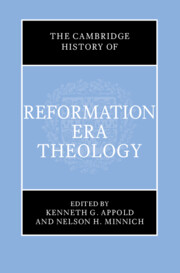Book contents
- The Cambridge History of Reformation-Era Theology
- The Cambridge History of Reformation-Era Theology
- Copyright page
- Contents
- Figures
- Acknowledgments
- Contributors
- Abbreviations
- Introduction
- Part One Theology in an Age of Cultural Transformation
- Part Two Schools and Emerging Cultures of Theology: Diversity and Conformity within Confessions
- Part Three Topics and Disciplines of Theology
- Index
- References
Part Three - Topics and Disciplines of Theology
Published online by Cambridge University Press: 27 September 2023
- The Cambridge History of Reformation-Era Theology
- The Cambridge History of Reformation-Era Theology
- Copyright page
- Contents
- Figures
- Acknowledgments
- Contributors
- Abbreviations
- Introduction
- Part One Theology in an Age of Cultural Transformation
- Part Two Schools and Emerging Cultures of Theology: Diversity and Conformity within Confessions
- Part Three Topics and Disciplines of Theology
- Index
- References
Summary

- Type
- Chapter
- Information
- The Cambridge History of Reformation Era Theology , pp. 403 - 761Publisher: Cambridge University PressPrint publication year: 2023
References
Bibliography
Bibliography
Bibliography
Bibliography
Bibliography
Bibliography
Bibliography
Bibliography
Bibliography
Bibliography
Bibliography
Bibliography
For a more extensive description see Ad Dudink and Nicolas Standaert, “Apostolate through Books,” Erik Zürcher, “Key Theological Issues,” and Nicolas Standaert, “Rites Controversy,” in Nicolas Standaert, ed., Handbook of Christianity in China, volume I: 635–1800 (Leiden, 2001), 600–631, 632–652, and 680–688.
For a very extensive bibliography to (Chinese) primary and secondary sources see Ad Dudink and Nicolas Standaert, Chinese Christian Texts Database (CCT-Database): www.arts.kuleuven.be/sinologie/english/cct.

